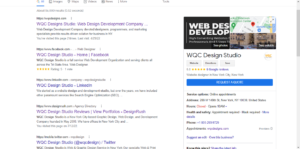Achieving higher positions on relevant search engine result pages is no mean feat and doesn’t happen overnight! It takes time, commitment, and consistency. Search Engine Optimization (SEO) practices like running an SEO campaign help grease the wheels.
A concrete SEO campaign strategy sets your organization up for success in every aspect. This includes appearing in top positions of relevant search queries, increased organic traffic, higher conversion rates, and propelling company growth.
Thinking of casting your dice on SEO marketing? Now is as good a time as any!
Keep reading to learn how to plan and launch a sales-generating SEO campaign from scratch!
6 DIY Steps To Build & Launch A Successful SEO Campaign In Less Than A Week
1. Define Your SEO Campaign Goals & KPIs
2. Examine Your Current SEO Health (SEO Audit)
3. Create A Target Topic & Conduct Keyword Research
4. Create A Solid Content Strategy
5. (Re) Optimize Your Content
6. Launch and Keep Tabs on The Campaign
1. Define Your SEO Campaign Goals & KPIs
 Whether you need more sales, sign-ups, bookings, or increased organic traffic, you require practical KPIs to track your SEO campaign progress, failures, and achievements. Tracking keyword ranking is a commonly used KPI but is limited. The best KPI is analyzing your web visitor’s behavioral data. Look at the clicks, impressions, level of engagement, page visits, and sessions to know if you’re achieving your goals. Tools like Google Analytics and Search Console may come in handy to help you interpret the data. Local businesses, however, may need to utilize keyword ranking analytic tools to see how their Google My Business Profiles are performing.
Whether you need more sales, sign-ups, bookings, or increased organic traffic, you require practical KPIs to track your SEO campaign progress, failures, and achievements. Tracking keyword ranking is a commonly used KPI but is limited. The best KPI is analyzing your web visitor’s behavioral data. Look at the clicks, impressions, level of engagement, page visits, and sessions to know if you’re achieving your goals. Tools like Google Analytics and Search Console may come in handy to help you interpret the data. Local businesses, however, may need to utilize keyword ranking analytic tools to see how their Google My Business Profiles are performing. 2. Examine Your Current SEO Health (SEO Audit)
Before you start your SEO campaign plans, perform a thorough SEO pulse-check on your website to see what’s working and what’s not. You can’t enroll in a race with an injured backbone! To make sure you cover everything, this updated 2022 SEO checklist will come in handy:
- Check your site’s speed?
- Is your website mobile-friendly?
- Is your website optimized for voice search?
- Are there broken links in your content?
- Is your content updated, and does it meet the length threshold?
- Find and delete dead pages?
- Are there indexing problems?
- Check for server errors
- Ensure that one version of your website is indexed
- Is your content optimized with the most recent keywords?
To sum it all up, ensure that your on-page and off-page SEO is in the right shape before proceeding!
3. Create A Target Topic & Conduct Keyword Research
It’s always better to optimize around topics relevant to your target audience rather than single keywords. First, you need to conduct in-depth keyword research and categorize similar keywords under one banner. One of the best tools for keyword research is Google Keyword Planner (You’ll need a Google Ads account to access this free keyword research tool).
You’ll come up with topics that naturally accommodate the keywords under them from these banners. Eventually, you’ll have several issues derived from your keyword research. This is the best approach because you’ll be able to cover similar customer queries under single topics, tackling everything there’s to know under each topic. Eventually, you’ll end up with comprehensive pieces of content that rank high on search engines and addresses all your customers’ concerns in one go!
In addition, you might also want to do a keyword gap analysis by checking which keywords your competitors are using or ranking high for that you’re not using. You can then incorporate them under your keyword groups.
4. Create A Solid Content Strategy
An SEO campaign can’t be executed without content. It’s at the backbone of every website and is used to create a bridge between the customer and the business. Keywords are inserted in the content, linking is done on content, and most SEO practices use the content as their basecamp. Any successful SEO campaign requires the support of a pillar content strategy. An effective SEO campaign content strategy is built around the brand’s & campaign’s goals, positive user experience, and updated keyword research. You must address all topics compiled from your keyword research and tailor your solutions to your customer’s specific needs! A great content strategy should also outline the means of content distribution and the mediums to be exploited. These include social media channels, landing pages, and sales promotion pages.
5. (Re) Optimize Your Content
Now that you’ve got your content strategy ready, the next thing to do is optimize or re-optimize your content for higher rankings. Content analysis tools come in handy in this step to help you improve your content readability, rankability, and overall quality. Don’t forget to optimize your social media content with high-ranking keywords, search phrases, hashtags, and high-quality media content. Ensure you maintain a high-quality standard across your website and social media pages.
6. Launch and Keep Tabs on The Campaign
Congratulations on reaching the final step in launching your SEO campaign! Ensure you’re all set and clear on the campaign goals and objectives. Pool your resources to ensure the campaign is a success. Always track down your campaign’s progress to identify potential challenges and opportunities. Evaluate your campaign’s performance regularly to see if it’s meeting the objectives or draining your resources for nothing. Make necessary changes and stop the campaign when it has exhausted its usefulness. Start another campaign!
Need Help Starting & Running your SEO Campaign Today?
 The experts at WQC Design Studio will guide you through every step of the way to plan and launch a sales-boosting SEO campaign. We’re a team of digital marketing experts with over 22 years of experience, offering dependable online marketing solutions like SEO, web design and development, content management, and more. We’re available 24/7 to help you realize your online marketing goals within a reasonable timeframe. Reach out now for quick assistance!
The experts at WQC Design Studio will guide you through every step of the way to plan and launch a sales-boosting SEO campaign. We’re a team of digital marketing experts with over 22 years of experience, offering dependable online marketing solutions like SEO, web design and development, content management, and more. We’re available 24/7 to help you realize your online marketing goals within a reasonable timeframe. Reach out now for quick assistance! WQC Design Studio Web Design and Development is proudly powered by WordPress